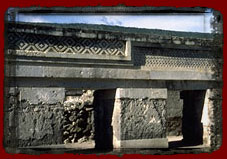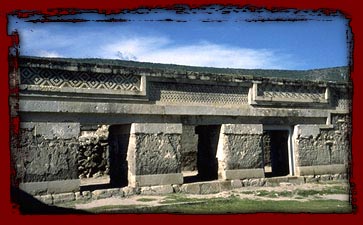 |
< Back to Archeological Sites

The ruins at Mitla are a source for many of the designs of the Zapotec
weavings. View photographs of details of the patterns carved into the stones
at Mitla in our slideshow below. Then view the rugs to see how these designs
correspond.
|
 |
View Mitla Site Plan

Rock shelters in the hills above Mitla give evidence of human habitation
during the Lithic stage, several thousand years B.C. Mitla itself was
occupied from about 100 A.D., though nearly all of the architecture
now to be seen at Mitla dates from the three centuries before the Spanish
Conquest in 1521.
The name Mitla comes from the Nahuatl Mictlan, and means place of the
dead. The 17th century Spanish priest Francisco de Burgoa described
Mitla as a center of Zapotec religion, ruled by a trained priesthood.
|
 |
